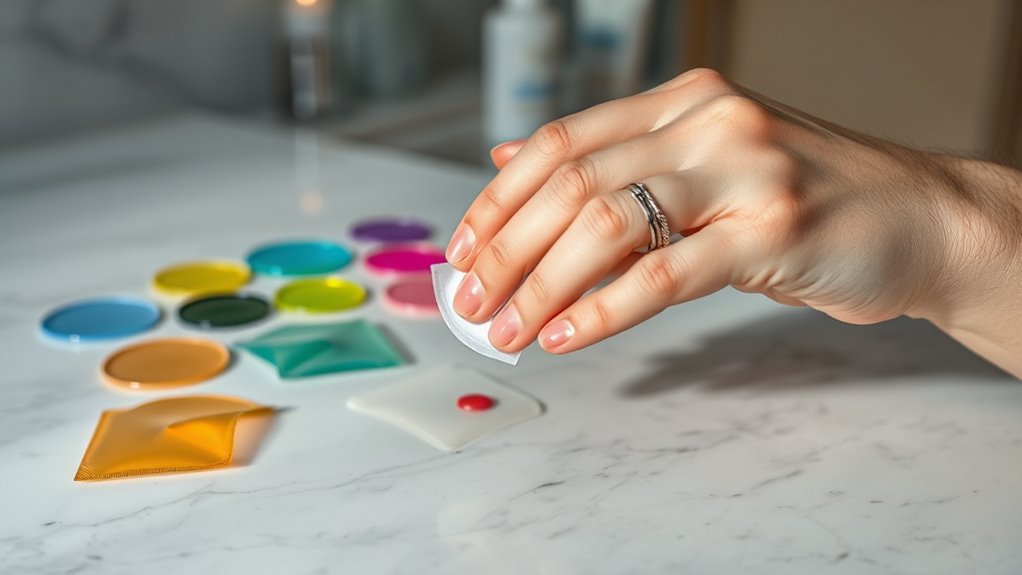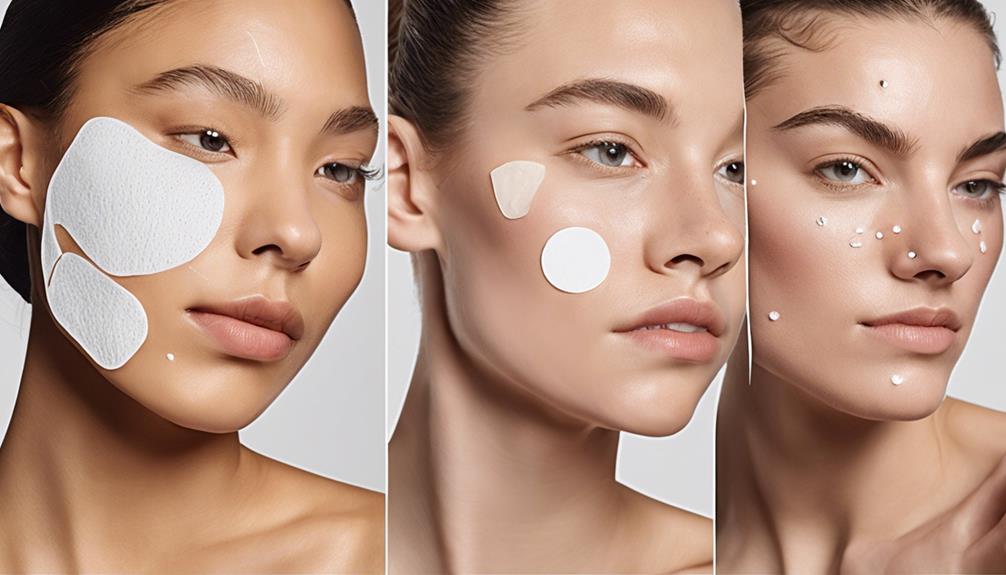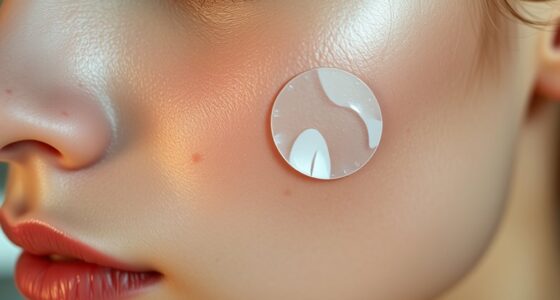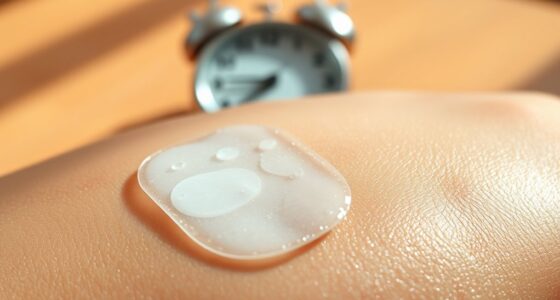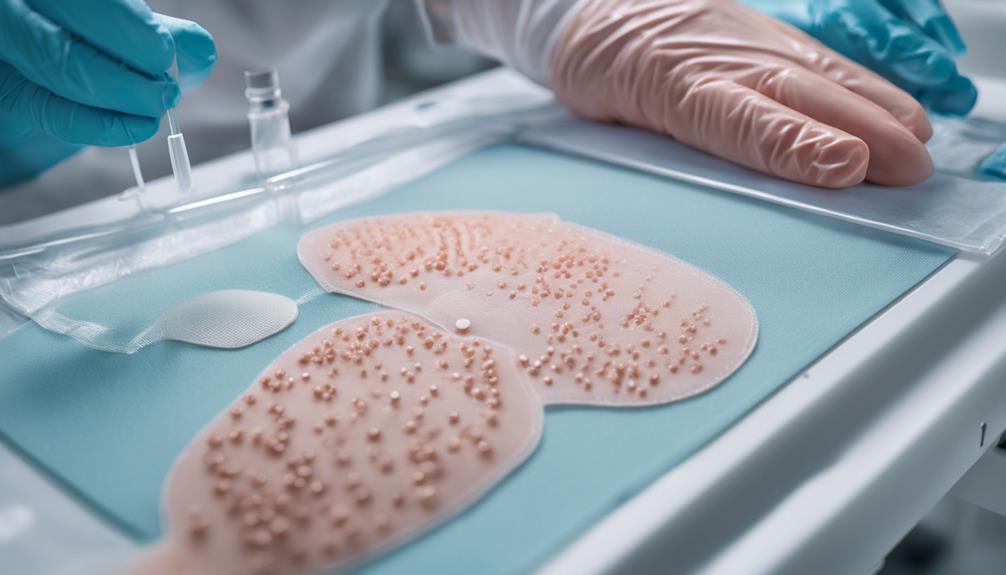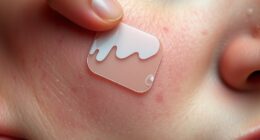Pimple patches are your go-to for quick zit-zapping success! These patches create a protective barrier over blemishes, absorbing excess fluid while keeping the area moist. Simply apply them to clean, dry skin and leave them on for at least 6-8 hours for ideal results. Choose patches based on your skin type, whether you need hydration or acne-fighting ingredients. For the best experience, keep a few tips in mind, and you’ll discover even more about making pimple patches work for you.
Key Takeaways
- Start with clean, dry skin to ensure optimal adhesion and effectiveness of the pimple patch.
- Apply patches only after a pimple has fully formed for better results.
- Choose patches based on your skin type and specific acne concerns for targeted treatment.
- Leave patches on for at least 6-8 hours, preferably overnight, for maximum healing benefits.
- Avoid layering other products beneath the patch to enhance effectiveness and prevent irritation.
Understanding the Different Types of Pimple Patches
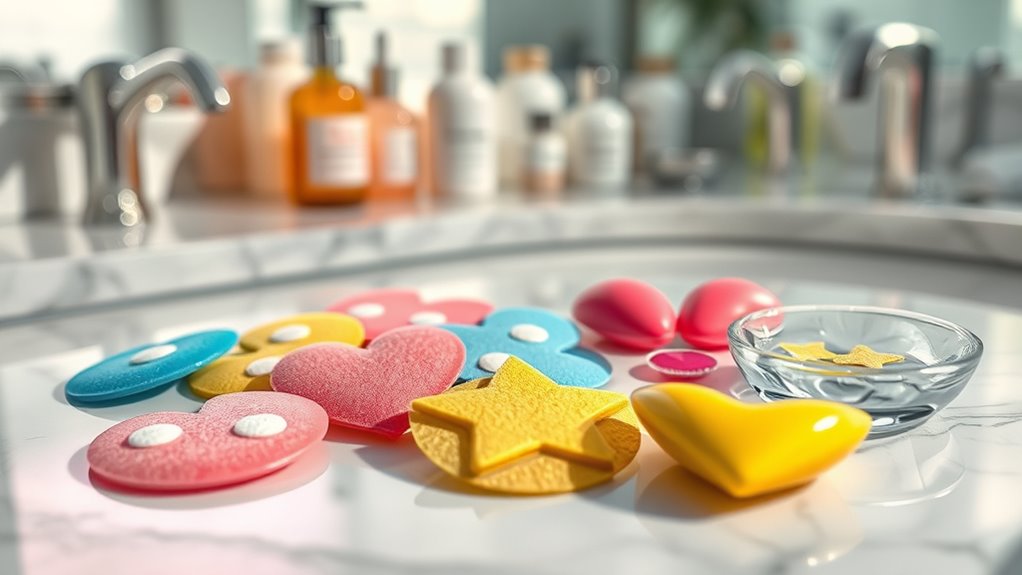
When it comes to pimple patches, you’ve got several types to choose from, each designed to tackle specific skin issues. Non-medicated hydrocolloid patches are perfect for surface-level pimples, absorbing excess fluid and pus. If you’re dealing with inflammation, opt for medicated patches containing salicylic acid or tea tree oil to fight bacteria. For deeper cystic acne, microneedling patches use tiny needles to deliver active ingredients more effectively. Additionally, best pimple patches for cystic acne often contain salicylic acid or hydrocolloid technology for enhanced effectiveness. You’ll also find adhesive variants made from silicone or hydrogel for better adhesion. Additionally, pimple patches are designed for targeted, convenient, and discreet treatment of breakouts.
How Pimple Patches Work on Your Skin

Pimple patches work by creating a protective barrier over your blemish, which helps to reduce irritation from dirt and bacteria. Made from hydrocolloid, these patches absorb excess oil and impurities while keeping the area moist for healing. This absorbent material is gentle on sensitive skin, making it a great option for various skin types. When you apply a patch on a fully formed pimple, it not only reduces inflammation but also prevents you from picking at it, lowering the risk of infection and scarring. For the best results, apply the patch on clean, dry skin and leave it on for at least 6-8 hours. This way, you’ll maximize its effectiveness in treating your acne, especially when you apply to developed pimples for optimal results.
Benefits of Using Pimple Patches for Acne Treatment

The convenience of pimple patches makes them a popular choice for acne treatment. They’re simple to apply—just verify your skin is clean beforehand. Plus, their thin, transparent design allows you to wear them discreetly day or night. Patches target specific pimples, protecting them from bacteria and environmental stressors, which helps reduce inflammation. By covering your pimple, they discourage picking, minimizing irritation and scarring. Hydrocolloid patches retain moisture, promoting faster healing while absorbing impurities. With soothing ingredients like tea tree oil, they calm inflammation and provide a cooling effect. Pimple patches fit seamlessly into your skincare routine, making them a cost-effective and gentle alternative for managing breakouts, especially for sensitive skin. Additionally, they create a protective barrier that helps shield blemishes from external irritants.
Step-by-Step Guide to Applying Pimple Patches

Applying pimple patches effectively can make a significant difference in your acne treatment routine. Start by cleansing the area around the pimple to prevent bacteria from getting trapped. Pat the skin dry, as moisture can cause the patch to slip off. Choose a patch that fits the size of your blemish, and avoid harsh products to reduce irritation. Gently press the patch onto the pimple, making sure no air bubbles or wrinkles are present. For microneedle patches, apply extra pressure to guarantee adhesion. Hydrocolloid patches are particularly effective for absorbing pus from whiteheads and providing a protective barrier. Avoid using other skincare products on the patch. Wear the patch for at least six hours, or overnight for best results, and replace it when it becomes saturated. Following these steps will enhance the patch’s effectiveness.
Limitations of Pimple Patches to Consider
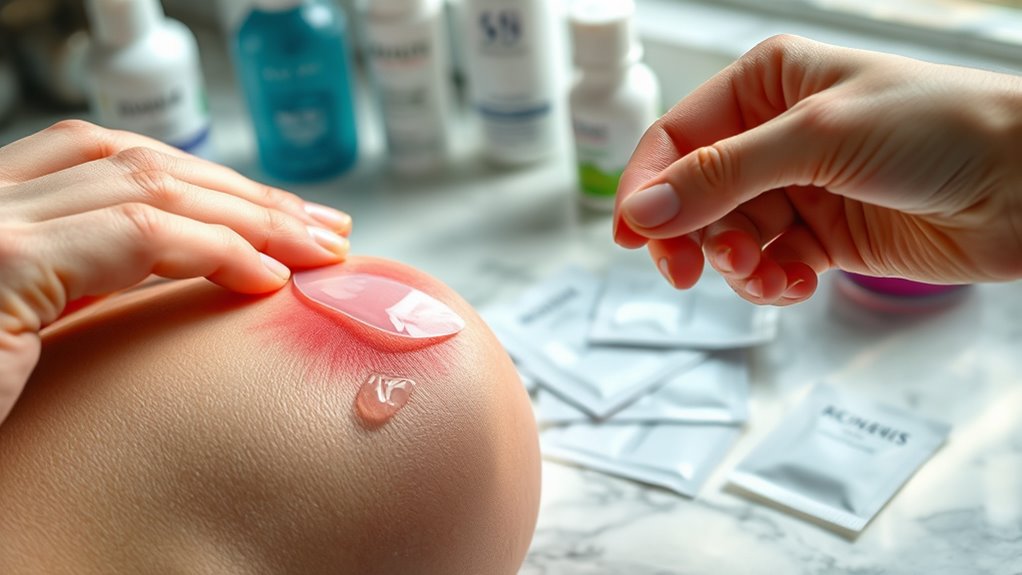
While pimple patches can be a handy tool for treating surface-level blemishes, they come with several limitations that you should consider.
First, they’re often ineffective for deeper acne, like cystic pimples, since they target only the surface. Plus, some patches may irritate sensitive skin, particularly those containing active ingredients. This is especially true for patches that contain known allergens, which can cause adverse reactions in some users.
There’s also the risk of pore occlusion, which can worsen your acne by trapping bacteria. Relying solely on patches might create a false sense of security, delaying necessary professional treatment. Economically, high-quality patches can be pricey and add to environmental waste.
Finally, inconsistent results can stem from incorrect application or inadequate size, making it essential to incorporate a thorough skincare approach.
When Is the Best Time to Use Pimple Patches?

Wondering when to apply pimple patches for the best results? The ideal time is as soon as you notice a breakout, particularly when you feel that familiar tingling sensation. Make sure your skin is clean and dry before applying the patch for maximum adhesion. For overnight treatment, apply the patch before bedtime, allowing it to work while your skin regenerates. If you prefer daytime use, opt for transparent or waterproof patches, so you can continue your daily activities without visible signs. Remember to leave the patch on until it turns white or opaque, which indicates it’s absorbed all it can. Additionally, using a patch creates a protective barrier over blemishes, which helps speed up healing. Avoid placing patches on open sores to prevent irritation and infection.
Choosing the Right Pimple Patch for Your Needs

Choosing the right pimple patch can make a significant difference in your skincare routine, especially when you consider the variety available.
If you’re dealing with surface-level pimples, hydrocolloid patches are your best bet, as they absorb pus and fluid. For more severe breakouts, consider medicated patches with salicylic acid or tea tree oil to tackle bacteria and inflammation. Hydrocolloid patches are particularly effective because they draw out fluid from the pimple, promoting faster healing.
Cystic acne might need advanced treatments, as pimple patches may not be effective. Pay attention to your skin type: sensitive skin benefits from gentle ingredients, while oily skin prefers patches that absorb excess oil.
Finally, opt for discreet, skin-toned or biodegradable options to fit your lifestyle and values. Choose wisely for the best results!
Tips for Maximizing the Effectiveness of Pimple Patches

To maximize the effectiveness of pimple patches, it’s crucial to prepare your skin properly before application. Start by cleansing your face with a gentle, non-comedogenic cleanser to remove dirt and oil. Pat your skin dry completely to guarantee the patch adheres well. Avoid heavy moisturizers or oily products right before applying the patch; a gentle toner can help maintain a clean surface if needed. Remember to wash your hands before touching the patch to prevent transferring oils or bacteria. Apply patches only when the zit has fully formed, ideally overnight for better results. Center the patch over the blemish, press down firmly, and replace it when it turns white or opaque for maximum effectiveness. Using a gentle toner can enhance patch effectiveness by ensuring a clean and dry surface.
Incorporating Pimple Patches Into Your Skincare Routine

Incorporating pimple patches into your skincare routine can greatly enhance your acne-fighting efforts, especially when you know how to use them effectively. Start by cleansing your skin thoroughly, making sure it’s clean and dry for ideal patch adherence. Apply the patches during your nighttime routine, allowing them to work while you sleep. Choose patches that suit your skin type—salicylic acid for oily skin and hydrating options for dry skin. Avoid layering other products beneath the patches to guarantee maximum effectiveness. Hydrocolloid patches absorb excess fluid and pus from pimples, helping to reduce inflammation. In the morning, gently remove the patches and continue with your regular skincare routine. With consistent use, you’ll likely see clearer skin over time, boosting your confidence and promoting faster healing.
Frequently Asked Questions
Can Pimple Patches Be Reused After Removal?
You shouldn’t reuse pimple patches after removal.
They’re designed for single use, and reapplying them can trap bacteria and impurities against your skin, leading to irritation and longer healing times.
Once a patch absorbs its maximum capacity, it loses effectiveness.
For the best results, always use a fresh patch to promote healing and minimize infection risk.
After removing one, clean and moisturize the area to support recovery.
How Do I Store Unused Pimple Patches?
Have you ever wondered how to keep your skincare products fresh?
Store your unused pimple patches in a cool, dry place, ideally sealed in their original packaging to preserve their adhesive. Avoid humidity and make certain your hands are clean when handling them.
Keep them accessible for quick use, and check for any signs of damage before applying. Following these tips will help you maintain their effectiveness whenever you need them.
Are Pimple Patches Safe for Sensitive Skin?
Yes, pimple patches can be safe for sensitive skin, especially if you choose non-medicated options like those from Neutrogena.
These patches are designed to minimize irritation and absorb excess oil without harsh chemicals.
Make sure your skin is clean and dry before application, and avoid using other products underneath.
After you remove the patch, applying a gentle moisturizer can help maintain hydration and comfort for your sensitive skin.
Can I Use Makeup Over Pimple Patches?
Imagine stepping out with confidence, even when a pimple’s lurking.
You can definitely use makeup over pimple patches! Just stick to lightweight products to avoid lifting them. Ultra-thin or invisible patches are your best bets for a seamless look.
Remember to apply makeup gently and avoid heavy foundations that may draw attention.
With the right approach, you can maintain your skin’s healing while looking fabulous at the same time.
How Often Can I Apply Pimple Patches?
You can apply pimple patches as often as needed, but it’s best to follow the manufacturer’s guidelines.
For small pimples, leave them on for about 6 to 8 hours until they turn opaque. Larger blemishes might require 12 to 24 hours for effective absorption.
Make sure to replace patches regularly to maintain hygiene and effectiveness, and listen to your skin’s response to find the right frequency that works for you.
Conclusion
So, there you have it—pimple patches are like tiny superheroes for your skin, swooping in to save the day while you sleep, binge-watch shows, or pretend to be productive. Just remember, they won’t fix your love life or make your morning coffee, but they’ll definitely tackle those pesky zits. So slap on a patch, kick back, and let them work their magic while you continue to navigate the chaos of adulthood. You’re welcome!
